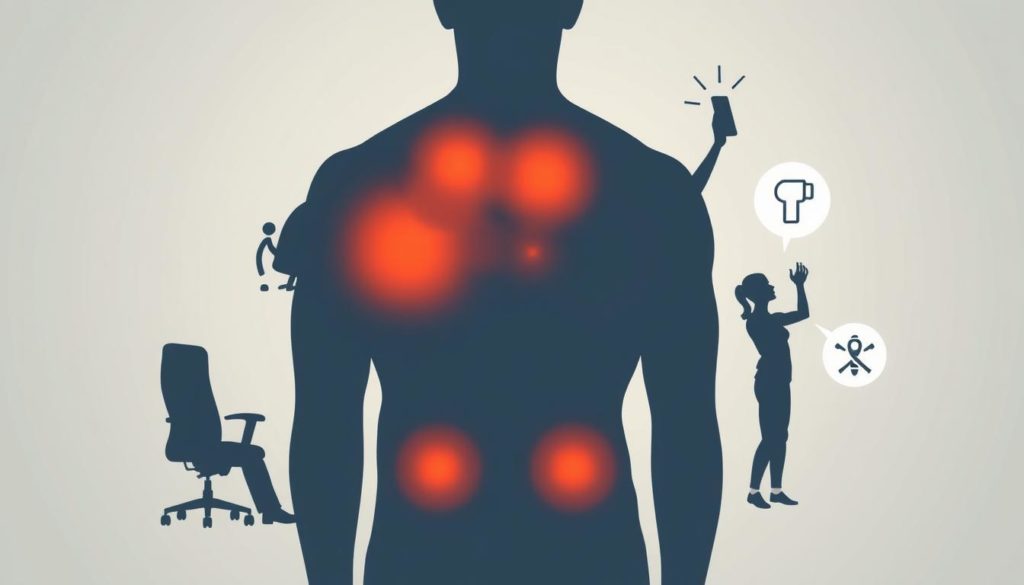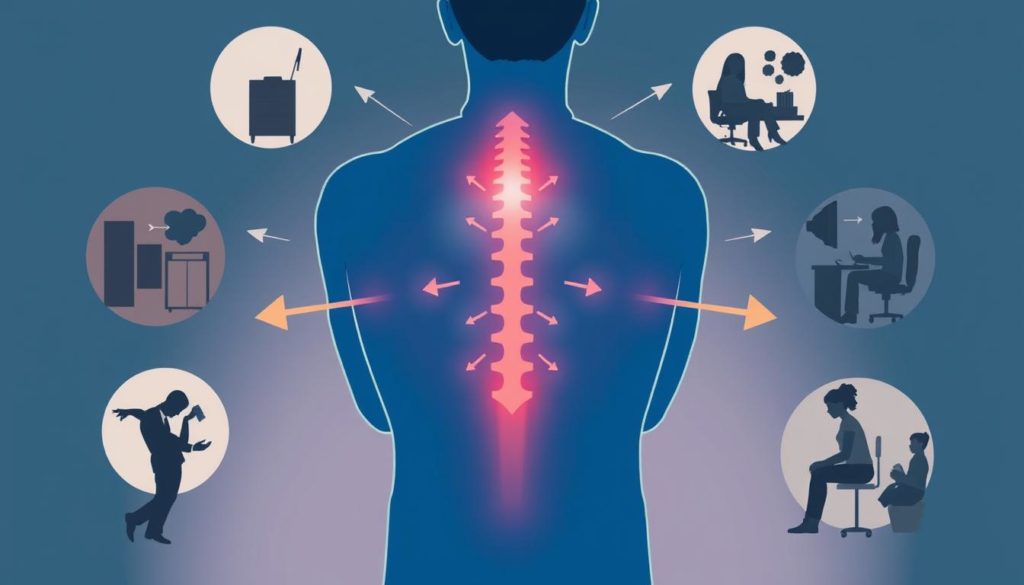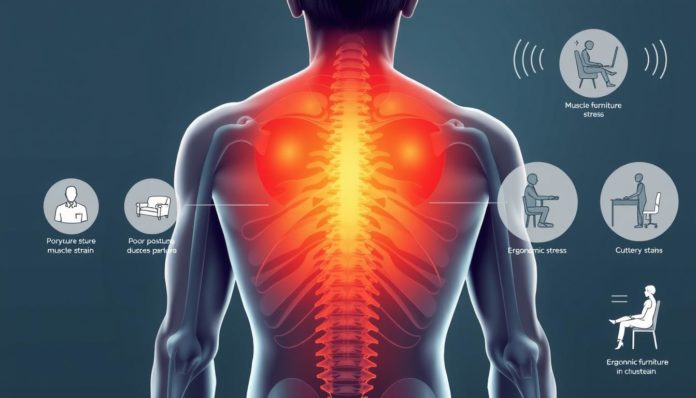Many suffer from upper back pain, which extends from the neck to the rib cage bottom. It’s essential to know the causes for effective treatment. Injuries, bad posture, and conditions like osteoarthritis are common culprits.
By examining these triggers, we can understand upper back pain better. This knowledge leads to more effective symptom management. This guide aims to help you care for and comprehend upper back issues better.
What is Upper Back Pain?
Upper back pain, or thoracic spine pain (TSP), impacts the area from the neck base to the lower rib cage end. This pain can touch any of the 12 thoracic spine bones. It presents symptoms that cause various discomfort levels.

Upper back pain’s causes are diverse. Things like bad posture, injuries, or health issues can all be culprits. It’s crucial to pinpoint the exact upper back discomfort sources for effective healing. Muscle strain, herniated discs, and stress are common causes.
Knowing what triggers upper back pain is key to preventing and handling it. Tasks like keeping a good posture, exercising regularly, and managing stress can ease or stop thoracic spine pain.
Let’s examine some typical upper back discomfort sources:
- Muscle overuse or strain
- Poor posture habits
- Traumatic injuries like accidents or falls
- Herniated discs in the thoracic spine
- Underlying conditions such as scoliosis or osteoarthritis
Dealing with these issues helps people find relief and boosts back health overall.
Common Symptoms of Upper Back Pain
Having upper back pain can affect your daily life in many ways. You might feel pain directly in the upper back or experience it spreading out. Knowing about these symptoms can help you find the right solution.

Localized Pain
Often, upper back pain starts as a specific spot of pain. You may feel tightness, throbbing, or sharp pains in the thoracic region. This discomfort can stick around and get worse when you move a lot or sit for too long.
Radiating Pain
Sometimes, the pain doesn’t stay in one place. It can reach out beyond its starting point. If you have neck and upper body pain, it might spread to your arms. This can lead to feelings of weakness or a painful burning sensation.
Numbness and Tingling
Numbness and tingling are also worrisome symptoms. They can travel from your upper back all the way to your fingertips. This can mess with your ability to move properly. It could also mean there is a nerve problem or something else wrong in your thoracic area.
These different symptoms of upper back pain show why it’s crucial to get medical help on time. With the right advice and pain management, you can improve your health and comfort.
Poor Posture and Upper Back Pain
Poor posture can greatly affect upper back pain. Slouching or not sitting correctly weakens upper back muscles. This leads to strains and discomfort. Over time, bad habits may also cause spinal issues, worsening the pain.
Effects of Slouching
Slouching’s effects are often ignored but are serious. It causes upper back muscles to weaken over time. This makes them more likely to get strained or injured. Weak muscles can reduce movement and make back pain worse.
Posture-related Curvatures
Bad posture can lead to or worsen conditions like kyphosis. This happens as the spine forms abnormal curves, increasing pressure on the spine and muscles. It’s important to maintain good posture to avoid chronic pain and keep the spine healthy.
Impact of Muscle Overuse
Musculoskeletal issues often come from overusing muscles in the upper back. This can lead to discomfort and less mobility. When muscles in this area are used too much in activities like sports or lifting, pain can happen.
Over time, this strain on the upper back muscles can cause specific conditions. These include muscle overuse back pain and muscle strain in the upper back. Signs of these issues include tightness and irritation. Sometimes, the pain gets worse, making daily tasks hard.
It’s important to know the differences and similarities between muscle overuse back pain and upper back muscle strain. This knowledge is key for effective management and treatment.
| Condition | Cause | Symptoms |
|---|---|---|
| Muscle Overuse Back Pain | Repetitive sports activity | Aching, tightness |
| Upper Back Muscle Strain | Frequent lifting or twisting motions | Irritation, sharp or dull pain |
To avoid these painful conditions, it’s vital to understand their root causes. Taking steps like resting properly and using correct techniques can help. This approach reduces the chance of chronic pain from muscle strain or overuse in the upper back.
Traumatic Injuries Leading to Upper Back Pain
Traumatic injuries can greatly affect one’s upper back. They often come from accidents, falls, or job-related injuries. These can cause pain right away or after some time. This shows how important it is to correctly diagnose and treat these injuries.
Accidents and Falls
Accidents and falls can lead to upper back pain. They might be simple slips or hard hits. This can result in fractured bones and severe back injuries. Getting the right medical help is key to stop long-term problems like pain and nerve damage.
Work-Related Injuries
Jobs can also cause upper back pain. Many require doing the same thing over and over, lifting heavy objects, or awkward bending. These actions can harm the muscles in the upper back. Using ergonomic tools and following safety rules at work can reduce injury risks.
Herniated Discs and Their Impact
Herniated discs in the thoracic spine are less common than in the lower back. But they can still cause a lot of upper back pain. This happens when the cushions between the spine’s vertebrae press on or irritate the spinal column.
The symptoms of a herniated disc can really shake things up. They often bring sharp pain to the upper back. Plus, they can cause numbness or weakness in the arms or legs, depending on which nerves are affected. Below is a table that outlines common symptoms and their effects:
| Symptom | Effect |
|---|---|
| Localized Pain | Sharp, stabbing pain in the upper back area |
| Numbness | Loss of feeling in arms or legs |
| Weakness | Reduced muscle strength in affected limbs |
It’s important to understand how herniated discs in the thoracic spine affect us. They can disrupt our daily life by causing a lot of pain. This makes getting the right diagnosis and treatment crucial.
Pinched Nerve Complications
A pinched nerve in the upper back can cause a lot of discomfort. It can interrupt your daily life. Knowing the symptoms and how to treat them helps manage the condition better.
Symptoms of a Pinched Nerve
If you have a pinched nerve in your upper back, you might feel different things. These include:
- Numbness or decreased sensation in the affected area
- Sharp, aching, or burning pain which may radiate
- Muscular weakness or loss of motor control, especially in the legs
- Sensation of pins and needles (paresthesia)
- Possible problems with controlling your bladder in serious cases
Treatment Options
Treatment for a pinched nerve in the thoracic spine depends on how severe it is. It also depends on what the patient needs. The options include:
- Conservative Management: Taking it easy, doing physical therapy, and taking anti-inflammatory drugs can help with minor issues.
- Medications: You might need over-the-counter or prescription pain medicines.
- Physical Therapy: Specific exercises and stretches can make the affected area stronger.
- Epidural Steroid Injections: Injecting steroids close to the swollen nerve can give temporary pain relief.
- Surgical Interventions: Surgery might be needed in serious cases to lessen the nerve pressure.
Finding the problem early and treating it right can stop other issues. It can make your life better.
Scoliosis and Upper Back Pain
Scoliosis causes a side curve in the spine. This curve can make the upper back hurt. Because of this, people with scoliosis often have back pain. These curves can mess with how spinal discs sit and pressure nerves. This leads to various symptoms.
- Nerve Irritation: The spine’s weird curve can stretch or bother nerves, causing pain.
- Disc Issues: The curves can move spinal discs out of place, leading to pain.
- Muscle Strain: Muscles might work too hard because of the curve, causing pain.
We need to know these things to manage the pain better. Here’s a closer look at how scoliosis affects back pain:
| Impact Factor | Description |
|---|---|
| Nerve Stretching | Scoliosis can make nerves stretch, causing pain. |
| Disc Misalignment | The curve might move spinal discs, causing discomfort. |
| Muscular Overstrain | Overworked muscles can lead to discomfort. |
Understanding these points helps those with scoliosis handle their symptoms better. This can make their lives easier.
Upper Back Pain from Osteoarthritis
Osteoarthritis is a common issue that often leads to upper back pain. It happens when the joint’s cartilage wears away over time. This causes bones to rub together, which can be very painful.
Degenerative Changes
The spine goes through changes as osteoarthritis gets worse. Cartilage breaks down and bone spurs might form. This can make bones grind against each other and press on nerves. It leads to numbness and a tingling feeling in the back, arms, and hands.
Joint and Bone Problems
Osteoarthritis can make joint spaces narrower and cause inflammation and stiffness. Spinal joint issues can make back pain worse when you move. These problems often need continuous care to lessen pain and make life better.
Myofascial Pain Syndrome
Myofascial pain syndrome is a long-term condition that causes pain in the connective tissue, called fascia. It often comes from injury or using muscles too much, causing lasting back pain. Stretching wrongly, poor posture, or straining muscles can start this painful syndrome. It leads to ongoing pain that goes beyond the first injury or issue.
People with this syndrome usually feel tight muscle knots, named trigger points, which hurt when touched. These points are known for causing tissue back pain. The pain often moves to other body parts, adding to chronic back pain issues.
Dealing with this syndrome can make daily life hard. It needs a correct diagnosis and treatment to manage. Treatments like physical therapy, massage, and exercises help. They aim to reduce pain and make moving easier, improving life for those with chronic back pain.
Knowing about myofascial pain syndrome and spotting its signs early helps treatment work better. If these symptoms sound familiar, seeing a doctor is key for getting the right help.
Spinal Infections as a Cause of Pain
Spinal infections are rare but serious, causing intense upper back pain. An epidural abscess, which means germs and pus in spinal area, causes swelling. This can cause a lot of pain, making it important to get medical help quickly.
Knowing about spinal infection back pain from an epidural abscess is important. As germs and pus build up, they press on the spine, causing a lot of pain. The pain starts off small but gets really bad over time.
If you feel the symptoms of a spinal infection or epidural abscess, getting help right away is crucial. Doctors usually treat it with antibiotics. Sometimes, surgery is needed to take out the pus and ease the pressure.
“Infections in the spinal area require quick diagnosis and treatment to prevent any long-term damage. A delay can lead to severe complications and persistent back pain,” notes Dr. Michael Ong, a specialist in infectious diseases.
It’s vital to catch and treat spinal infection back pain early. Doing so can prevent worse problems later. With expert care and fast action, these serious conditions can be managed and treated well.
Rare Causes: Lung Cancer and Tumors
In rare cases, upper back pain might mean something serious like cancer. This includes cancers of the spine or lungs. Tumors in the upper back can press on nerves and mess with the spinal discs. It’s important to get medical help early.
How Cancer Affects the Spine
Cancer can spread to the spine and cause a lot of pain and problems. Lung cancer, for instance, might push on the spinal cord or its surroundings. This can lead to bad pain, trouble with peeing, unexplained weight loss, and weak or numb legs.
Diagnosis and Treatment
Finding out if it’s spinal cancer means doing tests like scans and biopsies. Catching it early helps in treating it well. Treatment could be surgery, radiation, or chemo, depending on cancer’s type and stage. To learn more about upper back pain as a cancer sign, talk to a doctor.
Don’t ignore bad back pain thinking it’s just a muscle strain. If your back hurts a lot, or if there’s pain with other weird symptoms, see a doctor.
Preventing Upper Back Pain
To avoid upper back pain, regular exercise is key. Activities like swimming or weight training help a lot. They strengthen the upper back muscles, preventing pain.
It’s important to mix exercises that enhance both flexibility and strength. This keeps your back muscles in great shape.
Good posture is crucial for preventing upper back pain. Don’t slouch or lean too much, whether sitting or standing. Check your posture often and consider ergonomic furniture. Small changes can make a big difference for your back.
Lifestyle changes are also important for back health. Take short breaks if you sit for long hours. Warm up before physical activities to prevent injury. Speak with doctors for exercises tailored to protect your upper back.
FAQ
What is upper back pain?
Upper back pain, known as thoracic spine pain, covers discomfort from the neck’s base to the rib cage’s bottom. This area includes any of the 12 thoracic spine bones.
What causes upper back pain?
Various factors like injuries, poor posture, and disk problems can cause upper back pain. It’s important to know what triggers upper back pain for effective treatment.
What are the common symptoms of upper back pain?
Symptoms include tightness and sharp pains in the upper back. You might also feel pain radiating to your neck or arms. Other signs are numbness, tingling, weakness, and pain during deep breaths.
How does poor posture affect upper back pain?
Poor posture can weaken your upper back muscles. This leads to strains and increases the thoracic spine’s curvature. The result is ongoing pain.
What is the impact of muscle overuse on upper back pain?
Overusing muscles through sports or repetitive motions can lead to strains. Muscle tightness and irritation can happen if you don’t rest enough.
How do traumatic injuries lead to upper back pain?
Traumatic injuries, like those from accidents or falls, can cause immediate or delayed pain. In severe cases, such as fractured vertebrae, long-term complications may arise, requiring urgent care.
How do herniated discs affect the upper back?
Herniated discs in the thoracic spine can cause significant pain. Symptoms might include numbness or weakness in your arms or legs.
What are the complications of a pinched nerve?
A pinched nerve can lead to numbness in arms or legs and urinary control issues. Depending on severity, treatments range from conservative to surgical options.
How does scoliosis contribute to upper back pain?
Scoliosis causes abnormal spinal curves, stretching or irritating nerves. This changes spinal disc positions, leading to significant discomfort.
Can osteoarthritis cause upper back pain?
Yes, osteoarthritis can cause upper back pain as cartilage wears down. This leads to bone friction and nerve pressure, causing symptoms like numbness.
What is myofascial pain syndrome?
Myofascial pain syndrome is chronic pain from the back’s connective tissue, often due to injury or overuse. The pain can linger beyond the initial injury.
Can spinal infections cause upper back pain?
Spinal infections, though rare, can prompt severe outcomes without fast medical help. They can cause swelling and pain around the spine.
How can cancer cause upper back pain?
Cancer in the spine can press on nerves and mess with disc alignment, leading to pain. Fast diagnosis and treatment are vital.
How can I prevent upper back pain?
To prevent upper back pain, exercise regularly and stretch. Keep a good posture, lift safely, and take frequent breaks from sitting. Warm-up before activities and do muscle-strengthening exercises.


